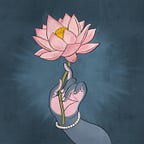Śiva’s Triśūla
The Triśūla or trident is perhaps one of the most striking of Śiva’s attributes. According to the Vātulaśuddhākhyagama, the significance of the trident are its three guṇas or qualitites — triguṇaṃ śūlam (“the trident is the three qualities”), namely sattva, rajas and tamas.
In the engraved seals of the Mohenjodaro and Harappa, there are forms of human faces with two inward bent horns and the head-dress. They are said to be representations of divinity. An examination of these figures bring out their similarity with the triśūla.
The association of Śiva with the Triśūla is found in Sangam literature. The invocatory verse of Akananuru speaks of the “muvay vel” or the ‘the three mouthed spear’ which is none other than the trident. The invocatory verse of Patiṟṟuppattu quoted by Naccinarkkiniyar mentions the word ‘sūlam’ and speaks of Śiva as “teriya sulam pititta cutarppatai katavul” — ‘the Lord of Time, of resplendent weapons holding the trident’. Today the trident is closely associated with goddesses — especially in Śakti shrines which are often marked with a trident.
Although the trident is an emblem of Śiva, and he always carries it as Bhikṣatana and Karikalamūrti, in these instances it is as ornament rather than a fierce weapon of destruction. The one important instance of Siva using his trident is in the myth of Andhaka, where he impales this demon upon his trident, and holds him aloft, in a powerful upward thrust of 45 degrees. The triśūla destroys all our obstructions towards redemption and salvation, obstructions which are personified as demons.
Below is one of Sundarar’s poems from the Tēvāram, with reference to Śiva as Andhaka wielding his triśūla:
“You cut off one of the Lotus-Dweller’s heads.
You destroyed Andhaka with your fiery trident.
Once when Neṭumal, lord of Tirumakal,
was offering splendid worship for many days,
a single flower was missing from the (garland of a) thousand;
to fill the gap, he adorned you with the lotus of his eye,
and you graciously gave him
the discus, victorious in battle,
O pure lord of Tirupputtūr rich in groves.
He took the bright discus that cleft Jalandhara,
who wanted war,
and gave it to that excellent one
who used his bright eye as a lotus.
The lord who crushed Indra’s shoulders
impaled Andhaka, who lived in darkness, upon his trident
and gave it to that excellent one.”
References:
- The Religion and Philosophy of Tevaram (Thevaram) M. A. Dorai Rangaswamy
2. The Dance of Siva: Religion, Art and Poetry in South India; David Smith
_____________________________________________________
If you find value in my work, I hope you consider becoming a patron of hindu aesthetic or making a one-time contribution to hindu.aesthetic@okicici .
Hindu Aesthetic requires a lot of time and effort and your support would mean that I can continue bringing you the best possible content. ❤
